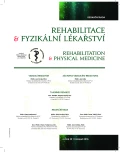-
Medical journals
- Career
Functional Independence Measure as an Indicator of Patient Disability - Evaluation of Practical Experiences
Authors: T. Osladil 1; E. Vaňásková 1,2; O. Němeček 1
Authors‘ workplace: Rehabilitační klinika, Fakultní nemocnice Hradec Králové 1; Univerzita Karlova v Praze, Lékařská fakulta v Hradci Králové, přednostka doc. MUDr. E. Vaňásková, Ph. D. 2
Published in: Rehabil. fyz. Lék., 23, 2016, No. 4, pp. 179-182.
Category: Original Papers
Overview
To assess the quality of care unbiased, we have used a licensed tool Functional Independence Measure (FIM) in the hospital's rehabilitation department for five years. The FIM instrument is a basic indicator of patient disability. FIM is used to track the changes in the functional ability of a patient during an episode of hospital rehabilitation care. The FIM has enabled us to monitor the progress of functional capabilities and independence in patients during hospitalization and to determine the degree of necessary help of another person. At the same time we were able to assess whether the patient is able to take care of himself at home and which kind of assistive device he or she possibly needs. Practical implementation of the FIM as an indicator of the quality in our department required administrative, organizational and personnel changes. Setting and maintain the standards of quality of collecting data entails a permanent control of the patients protocols and ongoing training of a medical personnel who performed the testing.
Keywords:
rehabilitation, disability, activity of daily living, Functional Independence Measure, FIM
Sources
1. LAW, J., FIELDING, B., JACKSON, D., TURNER-STOKES, L.: The UK FIM+FAM Extended Activities of Daily Living module: evaluation of scoring accuracy and reliability‘, Disabil. Rehabil., roč. 31, 2009, č. 10, s. 825-30. doi:10.1080/09638280802355049.
2. Uniform Data System for Medical Rehabilitation, dostupné: https://www.udsmr.org/
3. Uniform Data System for Medical Rehabilitation. 2009. The FIM System® Clinical Guide, Version 5.2. Buffalo, State University of New York at Buffalo: UDSMR.
4. Uniform Data System for Medical Rehabilitation.Validity and reliability of the FIM® instrument, dostupné: http://www.udsmr.org/Documents/UDSMR_Validity_Reliability_Of_The_FIM_Instrument.pdf.
5. VAŇÁSKOVÁ, E., ČELEDOVÁ, L, TOŠNEROVÁ, V.: Predikce výsledků rehabilitační léčby nemocných s cévní mozkovou příhodou v subakutní fázi. Rehabilitácia, roč. 46, 2009, č. 4, s. 249-254.
6. Vaňásková, E., Bednář, M.: Testování kvality života v neurorehabilitaci. Rehabilitácia, roč. 50, 2013, č. 1, s. 7-11.
7. VAŇÁSKOVÁ, E.: Testování v rehabilitační praxi – cévní mozkové příhody. 1. vyd., Brno, Národní centrum ošetřovatelství a nelékařských zdravotnických oborů, 2004, 65 s., ISBN 80-7013-398-8.
8. VAŇÁSKOVÁ, E., TOŠNEROVÁ, V., BUKAČ, J.: Hodnocení nemocných po cévní mozkové příhodě testy soběstačnosti na lůžkovém rehabilitačním pracovišti. Rehabil. fyz. lék., roč. 10, 2003, č. 2, s. 60-64.
9. WRIGHT, J. The Functional Assessment Measure. (2000). The Center for Outcome Measurement in Brain Injury. http://www.tbims.org/combi/FAM ( accessed August 15, 2016).
Labels
Physiotherapist, university degree Rehabilitation Sports medicine
Article was published inRehabilitation & Physical Medicine

2016 Issue 4-
All articles in this issue
- Functional Independence Measure as an Indicator of Patient Disability - Evaluation of Practical Experiences
- Possibilities to Influence the Risk of Falling in Seniors - Case Study
- Using Accelerometers to Assess the Effects of Hippotherapy on Movement Execution in Children with Spastic Cerebral Palsy - A Pilot Study
- Performance Induction Stimulation in the Terapy of Muculoskeletal Apparatus Conditions - A Pilot Study
- The Relation between Stress, Psychoneurotic Symptoms and Traits, and Neck Pain
- CI therapy – a Chance for Chronic Patients after Brain Damage
- Congenital Synostosis of Vertebras C4 a C5
- A Comment on BTX Application in the Rotation Form of Cervical Dystonia
- A Contribution of Acupressure in the Therapy of Patients Suffering from Primary Dysmenorrhea – a Contribution from Practice
- Rehabilitation & Physical Medicine
- Journal archive
- Current issue
- Online only
- About the journal
Most read in this issue- Congenital Synostosis of Vertebras C4 a C5
- The Relation between Stress, Psychoneurotic Symptoms and Traits, and Neck Pain
- Functional Independence Measure as an Indicator of Patient Disability - Evaluation of Practical Experiences
- CI therapy – a Chance for Chronic Patients after Brain Damage
Login#ADS_BOTTOM_SCRIPTS#Forgotten passwordEnter the email address that you registered with. We will send you instructions on how to set a new password.
- Career

